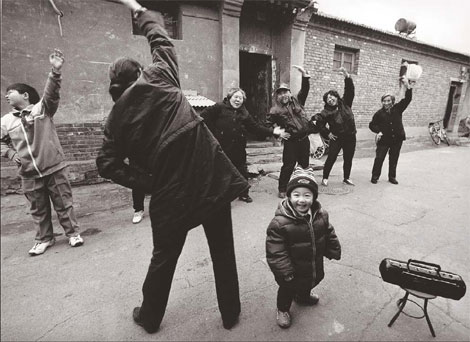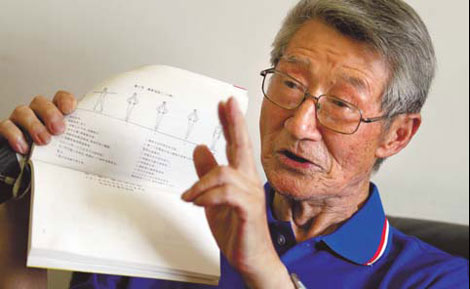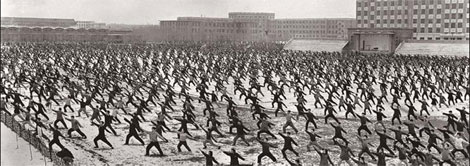Life and Leisure
Exercising on air
By Liu Zhihua (China Daily)
Updated: 2010-08-10 12:15
 |
Large Medium Small |
In 1951 a set of calisthenics created for ordinary people was broadcast over the radio. The exercises have endured their ups and downs over the years, and at one point looked like disappearing, but they are back once again to keep the nation healthy. Liu Zhihua reports

A group of Beijing residents practice calisthenics in a hutong community. Liu Yingyi / For China Daily |
On learning that Beijing People's Broadcasting Station will resume broadcasting the accompaniment for calisthenics on Monday, Cong Mingli, an 80-year-old Beijing resident, could not help indulging himself in recollections of his bitter-sweet days doing calisthenics to the first radio calisthenics broadcasts.
In 1951, under the direction of the central government, selected experts designed a set of calisthenics for ordinary people, and the newly formed nation popularized the exercises over the radio.
Previous statistics had shown that people in the war-devastated country had an average life expectancy of only 35 years. Broadcasting the new calisthenics was considered an important way of improving people's health. Cong was among the very first practitioners.
"The first time I learnt of the broadcast calisthenics was in December 1951. The movements were simple, but I was fascinated, because broadcast calisthenics was a new thing, different from other calisthenics," says Cong, then 21 and a sports major at Shandong Normal University in Qingdao, Shandong province.
After nearly 60 years, he still vividly remembers his first day: It was a sunny day, a teacher of the college gathered the students on some open ground, and began to teach them a set of calisthenics they had never seen before.
"We all learnt it with full attention, because we were going to teach others. I was nominated to perform for the whole university later on with three other students. I felt honored and loved the broadcast calisthenics even more," he says.
|
 Cong Mingli was one of the first practitioners of broadcast calisthenics. Jiang Dong / China Daily |
Since 1954, he has been editing broadcast calisthenics books and illustrations, and other physical education books for a living.
Following the first broadcast, the whole country soon adopted the calisthenics with enthusiasm. Everyday at 10 am and 3 pm, when the broadcast was aired, people would stop everything to do the calisthenics.
In the 1950s, a Soviet poet N S Tikhonov marveled at the spectacle in Beijing.
"When Beijingers do broadcast calisthenics, all the streets and alleys become a sports ground," he wrote.
People were enchanted with the novelty of the new workout method and sought to follow Chairman Mao Zedong's direction: "Strengthen our body to protect our homeland".
"It was the national will. We knew the Party was doing it for our sake. We were willing to obey the Party's orders," Cong says.
In 1953, after graduation, Cong was assigned to work as an editor for physical education books at People's Sports Publishing House, officially established in 1954.
From then on, broadcast calisthenics became an essential part of his work schedule. But his work was a merely small part of the promotion campaign.
Presses would publish books illustrating the moves and distribute them across the country. Records were produced for remote areas where the broadcast was not available. All the major newspapers would also spare a whole page for the illustrations, Cong says.
In July 1954, a second set of broadcast calisthenics replaced the former one, followed by a third set in 1957.
However, people's passion for broadcast calisthenics waned in the face of the disasters, famine, and political movements that struck the country in the early 1960s.
In 1960, Cong was sent to the countryside in Anhui province in Middle China to "experience labor work and get education from farmers".
One of his tasks was to teach farmers the new broadcast calisthenics, but he says their hearts weren't in it.
"Who cared about exercises when you are nearly starving to death?" Cong recalls.
|
Thousands of people gather for broadcast calisthenics in a stadium, in 1959. Xinhua |
In 1961, the fourth set of calisthenics was launched. But, during the "cultural revolution" (1966-76) radios were used for broadcasting discussions and arguments between opponents, and there was little time for broadcasting calisthenics.
In 1971, the fifth set of broadcast calisthenics went public.
"Occasionally, the accompaniment would ring out through the air, but it gained no attention," says Cong's colleague Liu Yi.
In the 1980s sports became a lifestyle choice and people abandoned the broadcast calisthenics for other forms of exercise.
Broadcast calisthenics was something for pupils, or for competitions between government agencies and institutions.
In 1990, the seventh set replaced the sixth set of 1981, hoping to win people back with its complexity. However, it received criticism rather than praise for its difficulty.
In 1997, a simpler eighth set was quickly launched. But stations almost all over China were already casting calisthenics aside in favor of other programs.
In 2003, after a 20-year break, Beijing People's Broadcasting Station resumed the calisthenics broadcast, but stopped in 2007 to air Beijing Olympic programs. Last Wednesday, it announced the program's revival.
"It is good that broadcast calisthenics is returning," says Cong. "People are different from the 1950s. They have much more choices of sports or entertainments. But they might like to do broadcast calisthenics due to its simplicity and convenience."
